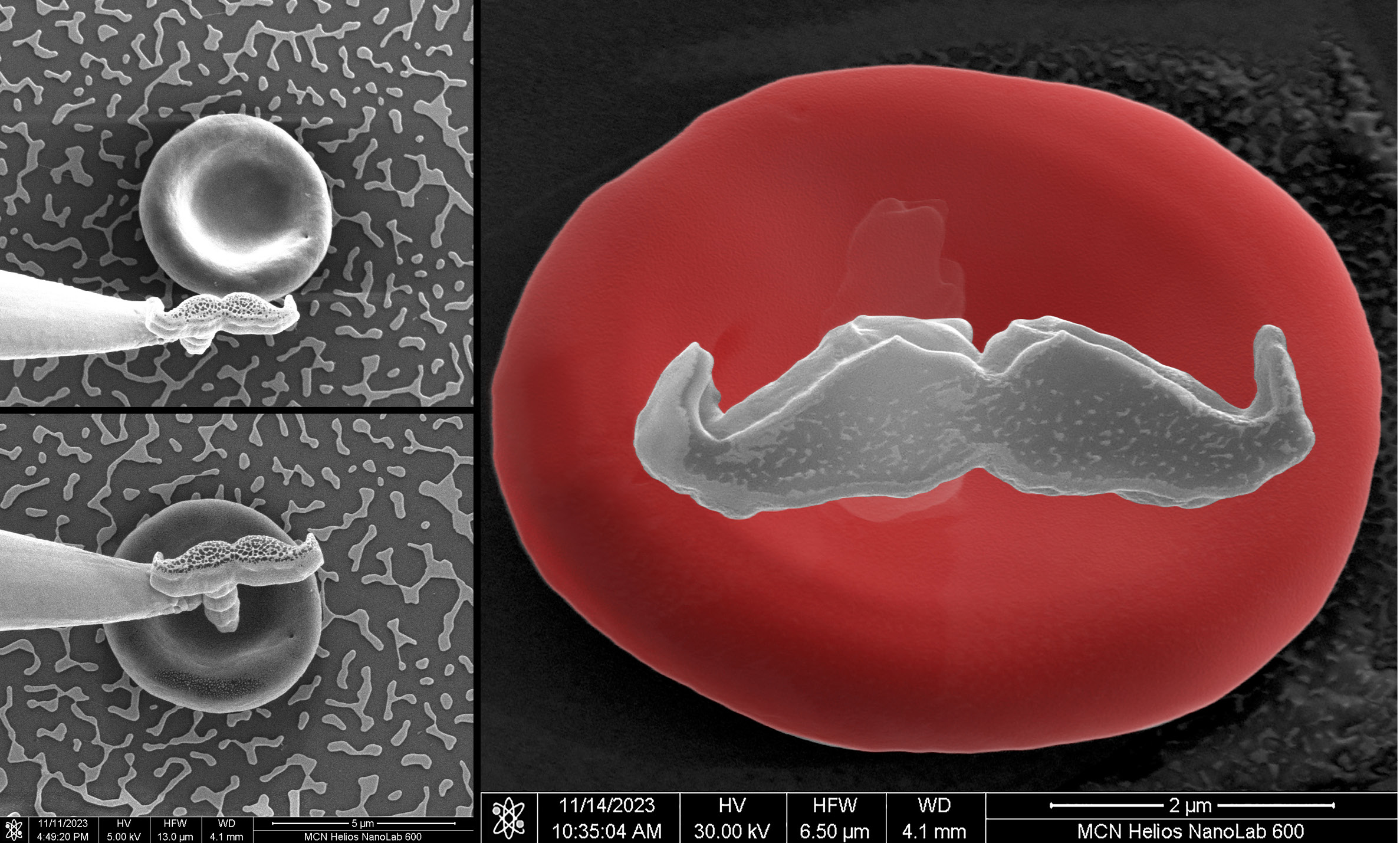Media release
From:
Australian scientists give red blood cell world’s tiniest mo
Move over Tom Selleck and Merv Hughes (or should we say Timothee Chalamet and Harry Styles?) Australian Red Cross Lifeblood has teamed up with some very clever Australian scientists to grow a Mo so tiny it cannot be seen with the naked eye.
The Australian National Fabrication Facility’s Melbourne Centre for Nanofabrication (MCN) and the Ramaciotti Centre for Cryo-Electron Microscopy at Monash University have put the world’s tiniest “Mo” measuring just 5 microns on a single blood cell.
The microscopic “stache” has been developed in support of global men’s health charity, Movember, and was designed to raise awareness of the vital role blood donation plays in men’s health.
Once Lifeblood collected the cell from a volunteer blood donor in Melbourne (every blood donation contains 2.3 billion cells) the team at MCN set to work to capture the image of the minuscule masterpiece using a remarkable instrument called a FIB-SEM.
“FIB-SEM is capable of imaging structures as small as 1/10,000th of the width of a human hair, by employing high-energy beams of metal ions to etch and deposit tiny structures,” explained Bernie Orelup, Engineering & Operations Manager at the Melbourne Centre for Nanofabrication
"The process to make the moustache is akin to constructing a miniature 'Mr. Potato Head' accessory, we meticulously crafted the tiny 'Mo' by layering 3D printed polymer resin on a tiny stalk and delicately attaching it to a single red blood cell using a micro manipulator,”
“The intricate process, using state-of-the-art nanofabrication techniques, allowed us to create a symbol of support for men's health that's invisible to the naked eye but carries a powerful message."
Before being placed in the microscope, the red cell was fixed to a gold coated slide and coated with a layer of metal about 15 nanometers thick.
This November Lifeblood is uniting with global men’s health charity Movember to champion men’s health and inspire millions of men across the country to donate blood or plasma.
“Some of the top leading causes of illness for men in Australia - heart disease, lung and throat cancers, and blood clots (including strokes) — often require billions of blood cells just like this one during treatment,” said Lifeblood spokesperson Alison Gould.
“Blood donation isn’t just a way of helping your mates, it is also a great way to get to know your own health while saving a life, with every donation including a check of your heart rate, blood pressure, and we also check iron store levels in new male donors,”
“While this moustache is small, we’re hoping it can make a big impact and inspire a few men (and women) out there to give blood and do their bit for men’s health,”
Throughout November, anyone who donates blood will receive a limited-edition bandage designed by Movember co-founder and artist Travis Garone.
Images and video of the Mo and the making of the Mo are available here along with B roll at the below link
https://redcrossblood.wistia.com/projects/i8iob9j6xh
ADDITIONAL QUOTES FROM THE SCIENTISTS
Bernie Orelup, Engineering & Operations Manager at the Melbourne Centre for Nanofabrication
"Our work at MCN often involves exploring the unseen world of nanoscale structures, and this project presented a unique challenge in making the invisible visible. The focused ion-beam scanning electron microscope (FIB-SEM) was our key to unlocking the secrets of this tiny 'Mo.' It allowed us to reveal a world that is usually hidden from view, emphasizing the importance of advanced scientific tools in unravelling mysteries on a miniature scale."
“We joined forces with Lifeblood and the team at Monash University to create the world's tiniest 'Mo' because we saw an opportunity to merge our expertise in nanofabrication with a noble cause. Supporting Movember and raising awareness about the importance of blood donation in men's health aligns perfectly with our mission to use nanotechnology for positive change."
Travis Garone, Movember Co-Founder
“Just when I thought I’d seen it all, a group of scientists come along and plant the world's tiniest moustache on a red blood cell. What a brilliant campaign to show the critical role that blood donation plays in men’s health – and what a huge testament to the creativity and dedication of those who continue to fly the flag for men’s health. I’m honestly in awe of the innovation. It’s proof that the human spirit, when fuelled by purpose, knows no bounds. I hope that this tiny Mo raises some much-needed awareness and sparks some important actions for men’s health this Movember.”
Multimedia






 Australia
Australia


